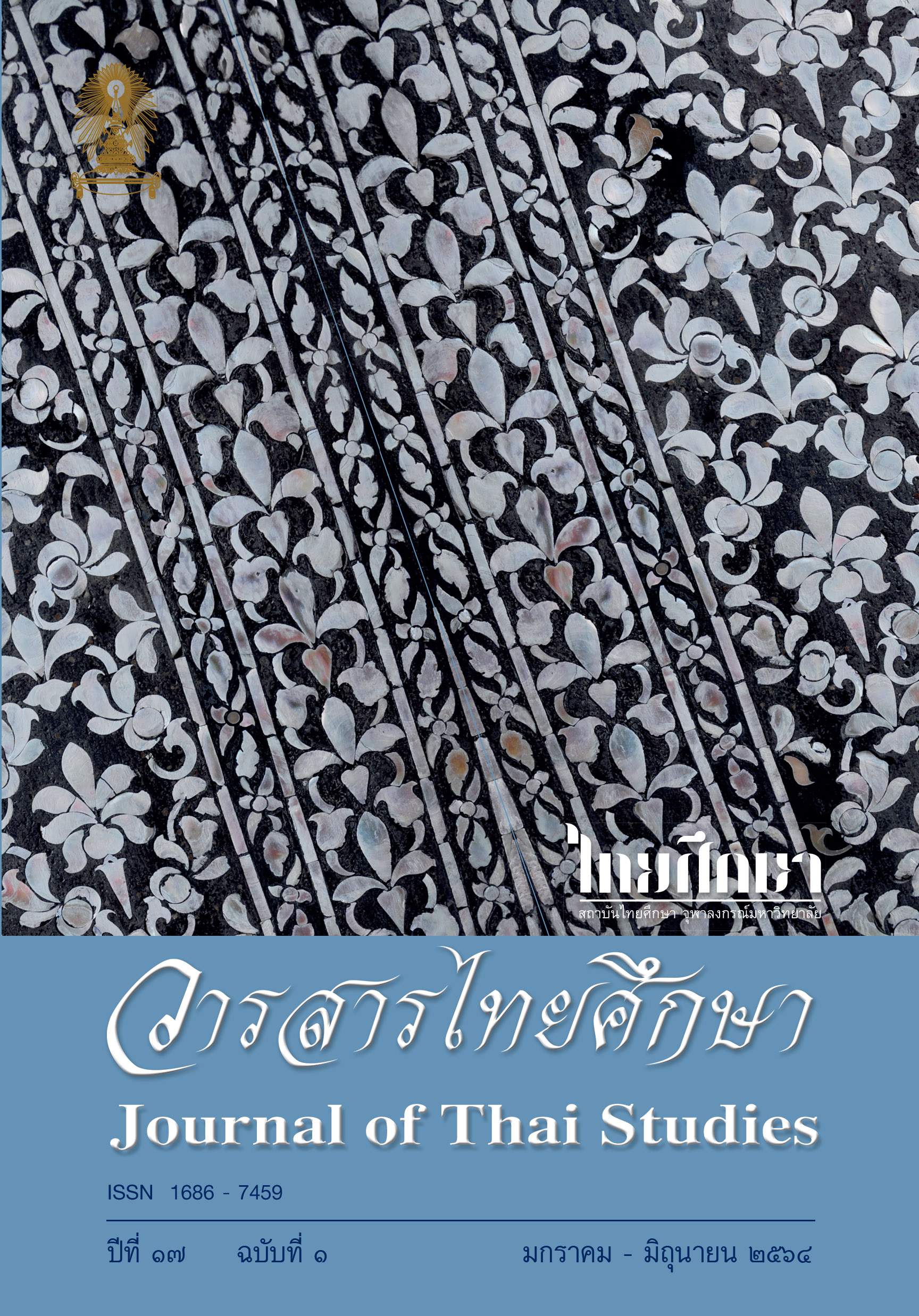Invocations for Buddha images in Amphoe Mueang Ubon Ratchathani
Main Article Content
Abstract
This research aims to explore the invocation for 38 sacred Buddha images found in the area of Mueang District, Ubon Ratchathani Province, using invocation gathered from 115 temples and 10 significant places in the vicinity of Muang District. The findings indicate that only seven highly revered Buddha images have invocations, written either in Pali or in both Pali and Thai: Phrachaoyai Inpaeng, Phrachaoyai Phrabot, Phrakaeo Phaithun, Phrabot Watklang, Phrachaoyai Ong Tueboromphotsat, Phrakeao Komen, and Luangphor Ngoen Wat Paknam (Bungsaphang).
An analysis of the data suggests: a) the concept of invocation to worship sacred objects in the vicinity of Muang District, Ubon Ratchathani, is based on the wish of local people to pay respect to revered Buddha images in their area. The recitation asks for blessings of luck and good life for the reciter. The structure of the invocation consists of the beginning in Pali describing feelings of respect for each particular Buddha image, while the middle or the end parts use both Pali and Thai with the content about being blessed with fame and fortune, happiness and prosperity, wealth and safety. The invocation reflects the humbleness and vulnerability of man who needs to ask for protection from the sacred Buddha image; b) the language pattern and communicative style of the invocation for sacred objects in Ubon Ratchathani was written to pay respect to seven Buddha images in the form of poetry using Pali and a combination of Pali and Thai. Pali is considered a sacred language and thus is suitable for the invocation. The use of a Pali and Thai combination is different from invocations found in other cultures, despite sharing the same idea. The invocation for the seven Buddha images shows an inventive language depicting regional Buddhist culture that places an important role on the use of Pali. As most local people believe that paying respect to sacred objects will bring blessings, the role of the invocation is to establish a channel to allow people to communicate with the Buddha images and express their wishes. The invocation works as a psychological device to make people feel secure, safe and relaxed. Invocations were born out of the belief that the Buddha images of Ubon Ratchathani are sacred and therefore their merits deserve invocation.
Downloads
Article Details

This work is licensed under a Creative Commons Attribution-NonCommercial-NoDerivatives 4.0 International License.
Journal of Thai studies is licensed under a Creative Commons Attribution-Noncommercial-NoDerivatives4.0 Intenational (CC BY-NC-ND 4.0) licence, unless otherwise stated. Plese read our Policies page for more information on Open Access, copyright and permissions.
References
Assavavirulhakarn, P. (2006). Imprecation and Blessing: An Interpretation of Epigrahical Data [Unpublished]. Department of Eastern Language, Faculty of Arts, Chulalongkorn University.
Bussayakul, W. (1990). Bapriansanskrit [Sanskrit textbook]. Bangkok: Chulalongkorn University.
Choksawat, S. and S. Ngopok. (2007). Wat Luang Ubon Ratchathani [Wat Luang in Ubon Ratchathani province]. Ubon Ratchathani: Ubon Ratchathani University.
Damien K. and S. P. Charles. (2010). Encyclopedia of Buddhism. London and New York: Routledge.
Keown, D. and C.S. Prebish. (eds.). (2010). Encyclopedia of Buddhism. Routledge.
Dorson, M. R. (ed). (1978). Folklore in the Modern World. Paris: Mouton.
Eoseewong, N. (2002). Khan mee khom wa duay phasa watthanatham lae amnaj [Sharp words about language, culture and power]. Bangkok: Matichon.
Gonda, J. (1963). The Indian Mantra. [Online]. Oriens (Producer). Brill (Distributor). Available from: http://www.jstor.org/about/terms.html. [2020, Aug 7]
Gonda, J. (1989). Prayer and Blessing Ancient Indian Ritual Terminology. Leiden. Netherlands: E.J. Brill.
Napum, N. (2015). Pali Praying Formulas of Significant Stupa and Buddha images in Northern Thailand. (master’s thesis) Chulalongkorn University, Bangkok, Thailand.
Noomsaotours (2021, February 2). “The first Temple in Ubon… Wat Luang” [webblog] Retrieved from https://www.noomsaotours.co.th/Accessinformation.
Punnothok, T. (1987). Sila jaruk nai Isan samai Thai-Lao [Isan inscription stones in the Thai-Lao period.]. Bangkok: Kunpinaksornkit.
Sangyu, T . (2006). Pathomhethangkarnprakotluangphorngurn Phraputtharuoprajamtapchaomuang Ubon Ratchathani sriwanalai [Primary cause of name of Laungpho Ngern, the Buddha of the army Ruler of Ubon Ratchathani Sriwanalai]. Bangkok: Ananta.
Siam Rat Tepitakang. (1995). Siam Ratthasarajathaniyang Mahamakutrajawittayalayena Pakasito [Tepitaka of Siam published by Mahamakut Buddhist University]. Bangkok: Mahamakutrajawittayalaya.
Siam Rat Tepitakatthakatha. (1992). Siam Ratthasarajathaniyang Mahamakutrajawittayalayena Pakasito [Commentary of the Tepitaka of Siam published by Mahamakut Buddhist University]. Bangkok: Mahamakutrajawittayalaya.
Srion, S, Phramaha. (2007). Invocation and Epilogue in Pali Literature: Concept, Form, and Language. (master’s thesis) Chulalongkorn University, Bangkok, Thailand.
Staal, F. (1986). The Sound of Religion. [Online]. Oriens (Producer). Brill (Distributor). Available from: http://links.jstor.org/sici?sici=0029-5973%28198606%2933%3A1%3C33%3ATSOR%3E2.0.CO%3B2-4. [2020, Jan. 7]
Tai Phracaoyai Ongtue, Wat. (2017). Wat Tai Phracaoyai Ongtue Ubon Ratchathani 2560. [The Tai Phracaoyai Ongtue temple in Ubon Ratchathani 2560]. n.p.
Thammapidok (P.A. Payutto), P. (2003). Poccananukromputthasat chabap pramuansap [Dictionary of Buddhist Terms.]. Bangkok: Mahachulalongkornrajavidyalaya.
Thitathan, S. (1990). Naewkid kiawkap sassana lae kwamchua nai sangkhom [Concepts of religions and beliefs in society]. In, Teaching materials regarding concepts of religions and beliefs in the society, unit 1-7. Nonthaburi: STOU Press.
Weesapen, W., et al. (2018). Pipitthapamwatmaneewanaram [Wat Maneewanaram Museum]. Ubon Ratchathani: Ployscreen.
Wisitpattanaporn, Phragru. (2014). Prawatwatklangnaimuang Ubon Ratchathani [History of Wat Klang in Ubon Ratchathani province]. Ubon Ratchathani: Ubolkic offset Publishing.
Yupo, Th. (1974). Arnupabpraparittapromduaytamnamlakhampla [The power of Paritt with legend and translation]. Bangkok: Prayurawong.
Interview Source
Pukhut, P. (2020, December 12) Personal Interview.
Phunaya, B. (2020, May 27) Personal Interview.
Phakdechanon, P. (2020, July 29) Personal Interview.


